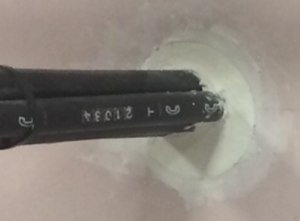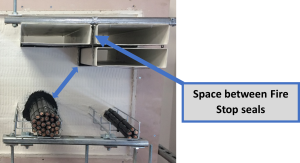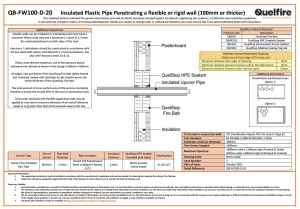It is important that services are installed with adequate space so that the firestop seals can be practically installed and so that they are within the tested scope of application.
‘Spacing requirements’ could refer to the required space between:
- services installed as individual seals, otherwise known as direct-to-wall seals – for example a pipe, cable and sprinkler installed directly through individual holes in a wall
- multiple services installed within a mixed penetration seal – for example between a pipe, cable, and sprinkler pipe within a fire batt seal in a letterbox
- the edge of separate apertures – for instance between two or more letterboxes within a fire-rated partition system
Why is spacing important?
Spacing requirements or spatial coordination, as defined by RIBA stage 3, is one of the Golden Rules identified in the ‘Firestopping of Service Penetrations – Best Practice for Design and Installation’ guide prepared by the ASFP and other related associations.
Golden Rule 3 states: ‘Identify all of the service types passing through the compartment floor or wall including any insulation products. Establish the space required to install and firestop the services.’
The spacing requirement of the service seals is critical because the system must be installed in accordance with the tested scope of application. The tested scope of application sets the parameters of certain things including how close seals can be to each other therefore, providing reasonable assurance as to how the application would be expected to perform in a real-life fire scenario.
If an application is untested or, for example, services were installed closer than the tested scope of application, then it is not known if the presence of one service would have an adverse effect on the performance of the neighbouring service and its seal.
What do the standards say?
Section 13.7 of BS EN1366-3:2021 effectively states that there should be a minimum of 100mm between each seal unless:
- there is test evidence for spacings of less than 100mm or
- one of the seals is tested to a different standard such as a door or damper in which case there should be a minimum of 200mm between the seal.
BS EN1366-3:2021:

It is important to remember that any dimensions are to be regarded as minimums.
Consideration for the practical buildability is important, as are any spacing requirements set out by the wall or floor system manufacturer.
For example, where two letterboxes in a fire-rated plasterboard wall with various pipes and cables (services tested to BS EN1366-3) are proposed, the standards would effectively permit just 100mm between them.
However, the wall manufacturer may require a larger space between them. This might be a specified measurement such as 200mm or 330mm or may even be a full stud width, so it important to verify the manufacturer’s requirements.
Remember the purpose of a firestop seal is to maintain the integrity of the wall or floor, so the firestop seal can only ever be as good as the substrate to which it is installed.
So, what does this mean in reality?
A single service penetration that goes directly through the wall or floor is very likely to have different spacing requirements compared to a multi-service penetration application.
A single service penetration would generally mean that a correct-sized hole is formed specifically for the firestopping seal/ product that will be used. For example, QuelStop Acrylic Sealant around a cable/ cable bunch.

As referred to above, as per section 13.7 of the BS EN 1366-3:2021, there would need to be a minimum of 100mm (unless it is tested closer) to another aperture containing a penetration seal tested to BS EN 1366-3, or a minimum of 200mm to a penetration tested to a different standard e.g., a door.
For instance, where these spacing requirements cannot be practically achieved, you may need to consider a multi-service penetration seal that may have a tested scope of application permitting closer positioning of the service penetration seals.
For example, you may need to consider using fire batt within a letterbox in a fire-rated partition wall instead of individual direct-to-wall seals.
The spacing requirement considerations for multi-service penetration seals are as follows:
- from the edge of the firestop seal to the edge of the aperture e.g., from an intumescent pipe wrap to the edge of the letterbox;
- the space between two (or more) seals of the same type of firestop seal e.g., between two intumescent wraps both around plastic pipes;
- and the space between the seals of penetrations of a different type e.g., between the wrap around a plastic pipe and a HPE seal around a CPVC sprinkler pipe.

Spatial requirements can vary extensively from one detail to another, so it is important that the correct standard installation detail is identified for the specific scenario.
Some of the details will have a tested scope of application of 0mm which effectively means that the fire stop seal can be touching (0mm) from the fire stop seal or it can be touching (0mm) from the edge of the letterbox, for instance.
The tested scope of application is as stated in the product’s classification report. If no information is stated, then the defaults set out in section 13.7, as referred to above, would be applicable.
As an example, the QRS Fire Sleeve, which is for use around a plastic duct, has a tested scope of application within QuelStop Fire Batt permitting 0mm spacing between, and 0mm from edge.
This means that multiple QRS Fire Sleeves can be stacked with 0mm between them and the QRS Fire Sleeve can be touching the edge(s) of the letterbox.
Where there are other service types that are tested to BS EN1366-3 (such as pipes, cables, sprinkler pipes etc.) in the same opening as the QRS Fire Sleeve/plastic vent duct, then the space between the QRS Fire Sleeve and the “other seals” would be as set out on each relevant detail.
This could typically be from 50mm to 100mm and the greater of the two details would take precedence.

The practical aspect of the installation also needs to be considered. Although the tested scope of application may permit 0mm spacing, it is worth remembering that site conditions for the installers can be very different from a fire test laboratory.
Therefore, consideration needs to be given to accessibility, timing and coordination or works and remembering that the scope of application sets out the minimum requirements.
As a general rule, it is better to provide at least 50mm between seals to allow the firestop installer sufficient room to install the products.
Where can spacing requirement information be found?
Whilst there is a lot of information on a Quelfire Standard Installation Detail, the spacing requirement information is generally in a table on the right-hand side of each detail.
Below is an example of our detail QB-FW100-D-20 with the section highlighted:

All our standard details can be located in the ‘Downloads – Standard Detail Drawings’ section on our website or you can use our helpful QuelSelector tool.
If you have any further questions, please don’t hesitate to get in touch with us at technical@quelfire.co.uk.

